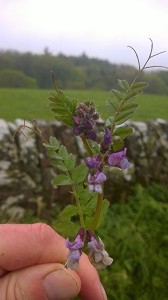Bush Vetch – Identification, Edibility, Distribution
Vicia sepium
– Edibility – 4 – Flowers and young shoot tips are delicious. This is not a plant to eat in large quantities, just a nibble or a garnish or scattered through a salad. It seems to be mostly ignored in foraging literature, with occasional insinuations of slight toxicity. This doesn’t bother me in the slightest, I eat loads of things that aren’t especially good for me, most in larger quantities than i’ll ever manage of this. See here. The seeds (one could hardly call them peas) can also be eaten after extensive boiling in changes of water. They are tiny and i’ve never tried eating them – and never will unless somebody tells me they are amazing.
– Identification – 4 – The blue/purple leguminous flowers on fine pea shoots creeping through hedges could easily be confused with wood vetch (vicia sylvatica) which is larger when fully grown, tufted vetch (vicia cracca) which has longer racemes of flowers, and common vetch (vicia sativa) which tends to be pinker. Personally, i’m happy to nibble any to see if they suit my taste, but again, none are especially good for you in quantity.
– Distribution – 5 – Very common in hedgerows throughout most of the UK.
These little tendrils of joy delight me with their quiet insidious clamberings over the less subtle denizens of the hedgerow. Suck the flowers for a tiny, yet hugely rewarding sweet nectar hit, then chew to enjoy generous pea flavours. The delicate leaves and tendrils from the end of the stems make excellent garnishes, in the vein of “microherbs” so popular with chefs nowadays. Only these are nicer. And free.
Browse more edible wild plants…
